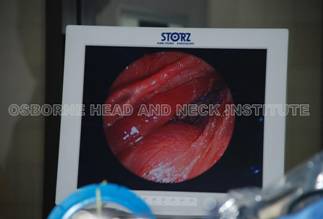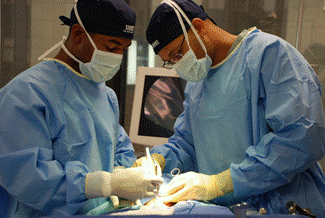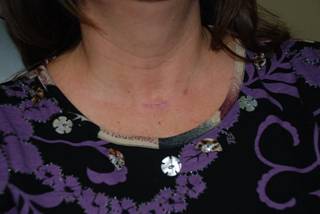|
OSBORNE HEAD AND NECK INSTITUTE.COM |
|
THE ART AND SCIENCE OF HEAD AND NECK SURGERY |
|
310 657 0123 |


|
Division of Head and Neck Surgery
"Head and neck cancer" refers to a range of differing cancers which arise in the tissues of the head and neck. The most important of these are cancers of the lip, mouth, throat, including voice box, nose, sinuses, cancers of the salivary glands and secondary cancers which have spread to involve the lymph glands of the neck from other sites. These tumors may affect speaking, chewing and swallowing, all vitally important functions in our day to day lives.
The Head and Neck cancer division is led by Dr. Ryan Osborne who has trained extensively in head and neck oncology with pioneers such as Paul Donald MD, FRCS, Jimmy Brown, MD, DDS, Thomas Calcaterra, MD and Dr. Wolfgang Steiner of the University of Göttingen, Germany. Please see Dr Osborne’s bio for further details. The primary focus of all the members of this division is the comprehensive management of benign and malignant tumors of the head and neck. Other special areas of interest include treatment of recurrent cancers, the minimally-invasive laser tumor resection, endoscopic skull base surgery, minimally invasive parathyroid and thyroid surgery, as well as diseases of the larynx, pharynx, and esophagus such as Zenker's Diverticulum.
Cancer Statistics
Head and Neck cancer accounts for 3-5 percent of all cancers in the United States. It is more common in individuals over age 50, and three times more common in men than women. It most commonly occurs in patients who smoke and drink and thus can be easily prevented by basic lifestyle changes. In recent years, however there have been head and neck cancers diagnosed in non-smokers and non-drinkers. There have also been recent associations noted with the human papilloma virus(HPV). As with other cancers, early diagnosis and prompt treatment improves survivability.
Risk Factors Chronic smoking Chronic alcohol consumption Poor oral hygiene Occupational hazards – wood dust inhalation and nickel exposure Ill-fitting dentures Chronic sun exposure (lip and skin cancers)
Most head and neck cancers are squamous cell cancers, as squamous cells represent the lining of the skin and the upper aero-digestive tract.
What are the Symptoms of Head and Neck Cancer 1. A sore that does not heal or a growth in the mouth or the tongue that persists beyond 2 weeks 2. A painless lump or swelling in the head, neck or side of the face. 3. Nasal problems such as bloody discharge, obstruction or chronic sinus trouble 4. Blood in saliva for several days. 5. Painful swallowing or breathing. 6. Changes in the voice that persist beyond 2 weeks An earache that persists in the absence of an ear infection especially if associated with painful swallowing.
Early detection and diagnosis
The initial step is a complete physical examination by an Otolaryngologist-Head and Neck Surgeon. Many initial lesions may be noted and are often biopsied by dentists. Additionally, blood tests, imaging – CT and MRI scans are used to determine extent of disease. Endoscopies (laryngoscopy, bronchoscopy and esophagoscopy) and biopsies are used to provide definitive diagnoses.
Treatment A comprehensive multidisciplinary approach to head and neck cancer is often warranted. Surgery, radiation and/or chemotherapy may be used in combination along with reconstructive surgery and good nutrition to help maintain and/or optimize good form and function with regards to breathing, swallowing and speech.
Specialized Procedures:
As mentioned above removal of most head and neck cancers may initially alter form and function. Also, given its location in very visible areas of your body, the physicians of the OHNI along with other physicians nationwide are moving to access tumors via small incisions and endoscopes thus decreasing your pain, facilitating quicker healing and allowing earlier return to normal activities. Some of these procedure include -
a. Minimally-Invasive Laser Tumor Resection b. Minimally Invasive Parathyroid Surgery c. Minimally Invasive Parotid Surgery d. Endoscopic Video-Assisted Thyroid Surgery e. Endoscopic Skull Base Surgery
|
|
Minimally Invasive Procedures
Minimally-Invasive Laser Tumor Resection Endoscopic Skull Base Surgery Minimally-Invasive Parathyroid Surgery |
|
Endoscopic Video-Assisted Thyroid Surgery |


|
Patient Resources
American Academy of Otolaryngology Head and Neck Surgery – http://www.entnet.org/healthinfo/tobacco/cancer.cfm National Cancer Institute - http://www.cancer.gov/cancertopics/types/head-and-neck/ Medline Plus: Head and Neck Cancer - http://www.nlm.nih.gov/medlineplus/headandneckcancer.html American Cancer Society – www.cancer.org Support for People with Head and Neck Cancers (SPOHNC) – www.spohnc.org Publications (available at http://www.cancer.gov/publications) National Cancer Institute Fact Sheet 7.48 , Follow-up Care: Questions and Answers National Cancer Institute Fact Sheet 10.19, Questions and Answers About Smoking Cessation Chemotherapy and You: A Guide to Self-Help During Treatment Eating Hints for Cancer Patients: Before, During, and After Treatment Radiation Therapy and You: A Guide to Self-Help During Treatment Taking Part in Clinical Trials: What Cancer Patients Need To Know |
